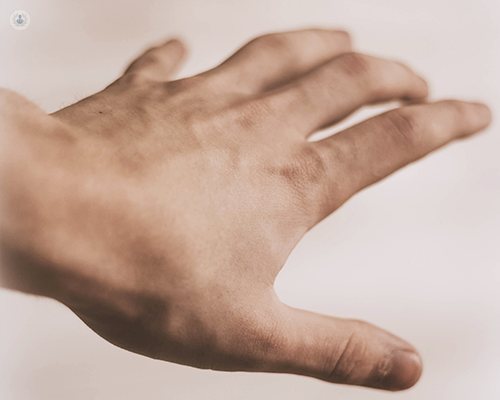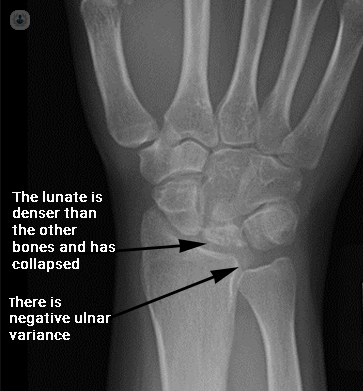Kienbock’s Disease
Autore:There are many possible reasons for hand and wrist pain, Kienbock’s disease is one of them. Sufferers of this condition may worry for their hand’s health but there are treatments available. Mr James Nicholl, a specialist in hand and wrist surgery, provides a brief but thorough explanation of the condition.

What is Kienbock’s disease?
Kienbock’s disease is the avascular necrosis of the lunate and this means that tissue or bone starts to die because of a lack of blood supply. Your lunate is a small bone in the middle of the wrist and like all bones, it needs a blood supply to keep it alive. If this blood supply fails, the bone will die and this can lead to fragmentation and fracture, and eventually arthritis of the wrist.
What are the causes?
In most cases, the reason someone develops Kienbock’s disease is unknown. There are some anatomical factors which make it more likely to develop, namely:
- The shape of the bone
- Whether there is just one main artery supplying the bone
- If the radius bone (the outer forearm bone) is relatively long compared with the ulna bone (the inner forearm bone).
- Sometimes, a history of trauma to the wrist contributes to the condition’s development.

Symptoms and diagnosis
The main symptom is pain in the middle of the back of the wrist. There may be some loss of wrist movement and the hand can be weak.
If Kienbock’s disease is suspected, then a plain X-ray will show an abnormality of the lunate bone, except in very early-stage cases. If the X-ray is normal, then an MRI (magnetic resonance imaging) scan is the next diagnostic method used.
What happens if the bone dies?
When the lack of blood supply to the bone persists and the bone dies (avascular necrosis), it will fragment and collapse. This will make the pain and stiffness worse. The collapse of the bone in the middle of the wrist will cause a change in the stresses on the other bones, such that the wrist becomes arthritic with more widespread pain around the wrist, swelling and worse stiffness.
Can Kienbock’s disease be cured or just treated?
In early cases, particularly in children, resting the wrist with a splint or plaster cast can allow the blood supply to the bone to become re-established and the bone to recover. If the bone hasn’t fragmented or collapsed, and the patient has a long radius bone compared with their ulna bone (negative ulnar variance) then shortening the radius can reduce the load to the lunate and allow it to recover. Various other operations have been claimed to treat the condition, but there is no evidence to support any one of them being better than the others.
Symptomatic relief can be provided by cutting the nerve supply to the wrist and removing any unstable flaps of the lining cartilage with keyhole surgery. Once the bone has collapsed or arthritis has developed, then surgical measures such as removing the three bones in the first row of the hand bones (proximal row carpectomy) or fusing the wrist may be required to control the pain.
Is Kienbock’s disease hereditary?
There is no evidence that Kienbock’s is hereditary, although there may a genetic element to its development.
If you’re worried about yours or a loved one’s hand and wrist health, don’t hesitate to book a consultation with Mr Nicholl via his profile.



